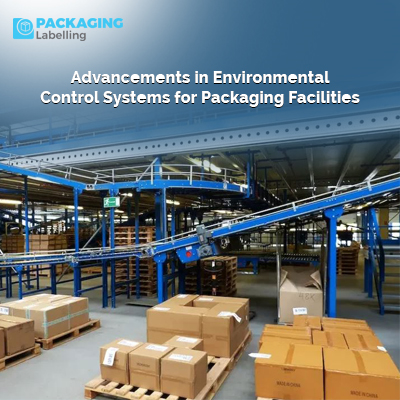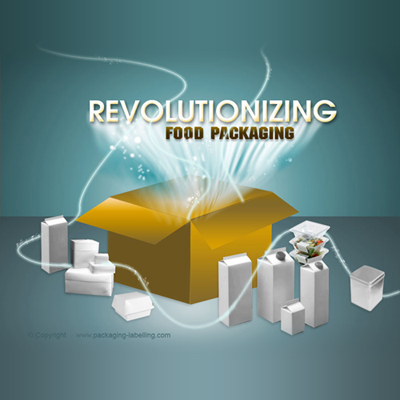Advancements in Environmental Control Systems for Packaging Facilities

Importance of environmental control in packaging facilities
In today's world, environmental control is a crucial aspect of packaging facilities. With the increasing emphasis on sustainability, businesses across industries are recognizing the need to reduce their environmental impact. Packaging facilities play a significant role in this endeavor as they are responsible for packaging, storing, and shipping products. By implementing effective environmental control systems, these facilities can minimize their carbon footprint and contribute to a greener future.
One of the primary reasons why environmental control is important in packaging facilities is the reduction of greenhouse gas emissions. Traditional packaging practices often result in the release of harmful gases into the atmosphere, contributing to air pollution and climate change. By implementing advanced environmental control systems, facilities can optimize their operations and reduce energy consumption, thereby minimizing their greenhouse gas emissions.
Another crucial aspect of environmental control in packaging facilities is waste reduction. Packaging materials, if not managed properly, can result in significant waste generation. This not only puts a strain on natural resources but also contributes to landfill pollution. By implementing advanced systems that focus on waste reduction, facilities can minimize their environmental impact and promote a circular economy.
Furthermore, environmental control systems also play a vital role in ensuring product safety and hygiene. By maintaining optimal temperature and humidity levels, these systems help prevent spoilage, mold growth, and contamination. This is particularly important in industries such as food and pharmaceuticals, where product quality and safety are of utmost importance. By investing in advanced environmental control systems, facilities can uphold high standards of product integrity while reducing their environmental impact.
| Also Read: Innovative Water Treatment and Environmental Control Strategies in Packaging and Labeling |
Environmental control in packaging facilities is essential for reducing greenhouse gas emissions, minimizing waste, ensuring product safety, and promoting sustainability. By embracing advancements in environmental control systems, businesses can not only meet regulatory requirements but also gain a competitive edge in an increasingly eco-conscious market.
A) Common challenges in maintaining environmental control
While environmental control is crucial for packaging facilities, it comes with its own set of challenges. These challenges need to be addressed to ensure the smooth operation of the facility and the effectiveness of the control systems. Some common challenges faced in maintaining environmental control are:
Temperature and humidity fluctuations: Packaging facilities often face temperature and humidity fluctuations due to factors such as weather conditions, external heat sources, and equipment operation. These fluctuations can impact the quality and integrity of packaged products, leading to spoilage, condensation, and mold growth. Maintaining optimal temperature and humidity levels consistently poses a challenge that needs to be overcome.
Energy consumption: Traditional environmental control systems can be energy-intensive, resulting in high energy consumption and increased carbon emissions. Balancing the need for environmental control with energy efficiency is a challenge that packaging facilities face.
Finding innovative solutions to reduce energy consumption without compromising on control is crucial for sustainable operations.
Compliance with regulations: Packaging facilities need to comply with various environmental regulations and standards. These regulations often require precise control of factors such as temperature, humidity, air quality, and waste management. Meeting these regulations consistently and efficiently can be challenging, requiring continuous monitoring and adjustment of environmental control systems.
Cost implications: Implementing and maintaining advanced environmental control systems can involve significant upfront costs. Balancing the cost of implementation with the long-term benefits and cost savings can be a challenge for packaging facilities. Return on investment and cost-effectiveness need to be carefully considered to justify the adoption of advanced systems.
Overcoming these challenges requires a combination of technological advancements, strategic planning, and continuous monitoring. Packaging facilities need to stay updated with the latest advancements in environmental control systems to address these challenges effectively and ensure sustainable operations.
B) Traditional environmental control systems vs. advanced systems
Traditional environmental control systems in packaging facilities have been predominantly manual and reliant on human intervention. These systems often involve manual monitoring of temperature, humidity, and other environmental factors, with adjustments made as and when required. While these systems have served their purpose, they have limitations in terms of efficiency, accuracy, and flexibility.
On the other hand, advanced environmental control systems leverage cutting-edge technologies to optimize operations and enhance control. These systems incorporate various components such as smart sensors, automated controls, and data analytics to provide real-time monitoring, analysis, and adjustment of environmental factors. By utilizing these advanced systems, packaging facilities can overcome the limitations of traditional systems and achieve higher levels of efficiency, accuracy, and control.
One key aspect that sets advanced systems apart from traditional systems is the automation and integration of processes. Advanced systems can be programmed to monitor and control various environmental factors simultaneously, ensuring precise and consistent control. This automation minimizes human error and allows packaging facilities to focus on other critical aspects of their operations.
Furthermore, advanced systems leverage data analytics to provide valuable insights into environmental control. By analyzing data collected from smart sensors and other sources, these systems can identify patterns, trends, and anomalies. This data-driven approach allows facilities to proactively address environmental control issues, optimize energy consumption, and improve overall efficiency.
Advanced environmental control systems offer significant advantages over traditional systems in terms of automation, integration, accuracy, and efficiency. By embracing these advancements, packaging facilities can enhance their environmental control capabilities and achieve sustainable and cost-effective operations.
C) Key advancements in environmental control systems
In recent years, there have been several key advancements in environmental control systems for packaging facilities. These advancements have revolutionized the way packaging facilities operate, enabling them to achieve higher levels of efficiency, sustainability, and control. Some of the key advancements in environmental control systems are:
Smart sensors: Smart sensors play a crucial role in advanced environmental control systems. These sensors are capable of monitoring various environmental factors, such as temperature, humidity, air quality, and pressure, in real-time. By collecting and transmitting data to a central control system, smart sensors enable precise monitoring and adjustment of environmental conditions.
Automated controls: Automation is a significant advancement in environmental control systems. By incorporating automated controls, packaging facilities can achieve consistent and precise control of environmental factors. Automated controls can be programmed to adjust temperature, humidity, and other parameters based on predefined thresholds, ensuring optimal conditions for product packaging and storage.
Data analytics: Data analytics is another key advancement that has transformed environmental control systems. By analyzing data collected from smart sensors and other sources, packaging facilities can gain valuable insights into environmental conditions, energy consumption, and system performance. This data-driven approach allows facilities to identify areas for improvement, optimize energy usage, and make informed decisions regarding environmental control.
Integration with other systems: Advanced environmental control systems can be integrated with other systems, such as inventory management and supply chain systems. This integration enables seamless coordination and communication between different aspects of the packaging facility, optimizing overall operations and ensuring efficient environmental control.
Remote monitoring and control: With advancements in connectivity and technology, environmental control systems can now be monitored and controlled remotely. This remote monitoring capability allows facilities to stay updated on environmental conditions and make adjustments as necessary, even when personnel are not physically present at the facility. Remote control enhances flexibility, efficiency, and responsiveness in environmental control.
By embracing these key advancements, packaging facilities can achieve higher levels of efficiency, sustainability, and control. These advancements enable facilities to optimize their operations, reduce energy consumption, minimize waste, and ensure product safety and integrity.
D) Energy efficiency and sustainability in packaging facilities
Energy efficiency and sustainability are critical aspects of environmental control in packaging facilities. By optimizing energy consumption and embracing sustainable practices, facilities can reduce their carbon footprint, minimize waste, and achieve long-term cost savings. Several strategies can be employed to enhance energy efficiency and sustainability in packaging facilities:
Efficient equipment and systems: Investing in energy-efficient equipment and systems is a fundamental step towards achieving energy efficiency. Energy-efficient lighting, HVAC systems, and packaging machinery can significantly reduce energy consumption without compromising on performance.
Renewable energy sources: Integrating renewable energy sources, such as solar panels or wind turbines, can help packaging facilities reduce their reliance on traditional energy sources. By generating clean energy on-site, facilities can minimize their carbon emissions and achieve greater energy independence.
Waste heat recovery: Packaging facilities generate a significant amount of waste heat during operations. By implementing waste heat recovery systems, this heat can be captured and used for other purposes, such as heating or powering other processes. This reduces the demand for additional energy sources and maximizes energy efficiency.
Optimized insulation and airflow: Proper insulation and airflow management are crucial for maintaining optimal temperature and humidity levels in packaging facilities. By ensuring effective insulation and implementing airflow management strategies, facilities can minimize energy loss and optimize energy usage.
Waste management and recycling: Effective waste management and recycling practices are essential for sustainability in packaging facilities. By implementing recycling programs, reducing packaging waste, and utilizing recycled materials, facilities can minimize their environmental impact and promote a circular economy.
Employee awareness and engagement: Creating a culture of energy efficiency and sustainability among employees is vital for long-term success. Training programs, awareness campaigns, and incentives can encourage employees to adopt sustainable practices and contribute to the overall energy efficiency of the facility.
By implementing these strategies and embracing energy-efficient practices, packaging facilities can achieve substantial energy savings, reduce their environmental impact, and promote sustainability.
E) Benefits of investing in advanced environmental control systems
Investing in advanced environmental control systems for packaging facilities offers numerous benefits for businesses across industries. These benefits go beyond energy efficiency and sustainability and extend to various aspects of operations and competitiveness. Some key benefits of investing in advanced environmental control systems are:
Improved product quality and safety: Advanced environmental control systems ensure optimal conditions for product packaging, storage, and transportation. By maintaining precise control over temperature, humidity, and other environmental factors, these systems help prevent spoilage, contamination, and product degradation. This, in turn, enhances product quality, safety, and customer satisfaction.
Enhanced operational efficiency: Advanced systems enable automation, real-time monitoring, and data analytics, leading to enhanced operational efficiency. By minimizing manual intervention and human error, these systems streamline operations and reduce the risk of environmental control issues. This results in improved productivity, reduced downtime, and cost savings.
Regulatory compliance: Packaging facilities need to comply with various environmental regulations and standards. Advanced environmental control systems facilitate compliance by providing precise control and monitoring of environmental factors. By meeting regulatory requirements consistently, facilities can avoid penalties, maintain a positive reputation, and gain a competitive edge.
Cost savings: While the upfront investment in advanced environmental control systems may be significant, the long-term cost savings can be substantial. These systems optimize energy consumption, minimize waste, and reduce the risk of product spoilage or contamination. By achieving energy efficiency and minimizing waste, packaging facilities can lower their operational costs and improve their bottom line.
Competitive advantage: In an increasingly eco-conscious market, businesses that prioritize sustainability and environmental control gain a competitive advantage. Investing in advanced environmental control systems demonstrates a commitment to sustainability and positions packaging facilities as leaders in their industry. This can attract environmentally-conscious customers, partners, and investors, leading to business growth and expansion.
Investing in advanced environmental control systems for packaging facilities offers multiple benefits, including improved product quality and safety, enhanced operational efficiency, regulatory compliance, cost savings, and a competitive advantage. By embracing these benefits, businesses can position themselves as industry leaders and contribute to a greener and more sustainable future.
F) Considerations for choosing the right environmental control system
Choosing the right environmental control system for a packaging facility is a crucial decision that requires careful consideration. Several factors need to be taken into account to ensure that the chosen system aligns with the facility's requirements and goals. Some key considerations for choosing the right environmental control system are:
Facility size and layout: The size and layout of the packaging facility play a significant role in determining the type of environmental control system required. Facilities with multiple zones or specialized areas may require a system that can accommodate different environmental conditions simultaneously. Understanding the facility's size and layout is essential to choosing a system that provides optimal control and coverage.
Environmental factors: Different products and industries have varying environmental requirements. Temperature, humidity, air quality, and pressure are some of the key factors that need to be controlled. Assessing the specific environmental factors relevant to the facility's operations is crucial to selecting a system that can meet those requirements effectively.
Regulatory compliance: Packaging facilities are often subject to regulatory standards and guidelines related to environmental control. It's important to choose a system that complies with these regulations, ensuring that the facility operates within legal requirements and maintains product quality and safety.
Conclusion:
In conclusion, environmental control systems are indispensable for modern packaging facilities, playing a pivotal role in reducing greenhouse gas emissions, minimizing waste, ensuring product safety, and promoting sustainability. Despite challenges like temperature fluctuations and energy consumption, advancements in smart sensors, automation, data analytics, and integration have revolutionized environmental control, offering benefits such as improved product quality, operational efficiency, regulatory compliance, cost savings, and a competitive edge. Choosing the right environmental control system involves considering facility size, environmental factors, regulatory compliance, and aligning with sustainability goals, ultimately contributing to a greener and more efficient packaging industry.









.jpg)